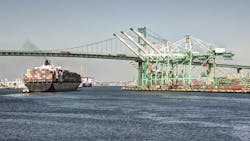Ocean Freight Routing Terms Explained
The ocean freight industry uses many acronyms to describe a shipment’s routing. Some of the acronyms are easy to decipher, while others are sometimes used interchangeably or only have the slightest of differences. Understanding which is which can be beneficial, as we’ll explain later.
Here are some of the most common ocean freight routing terms that are important to know.
AWS
This acronym stands for All Water Service, which is one of the most cost-effective ways to ship your cargo, and also one of the most eco-friendly; however, it’s also one of the slowest forms of freight transportation. With AWS, your cargo will be shipped from the port of origin to its destination using only water routes. For example, a shipment from China to the East Coast would go through the Panama Canal to reach its destination and vice versa.
MLB
This acronym stands for Mini Land Bridge. This term is used to describe an intermodal freight service that utilizes ocean and truck or rail to transport to another port location, for example, a shipment coming from Shanghai to New York via Long Beach. The land between the ocean port and the destination port is the “land bridge.”
IPI
Inland Point Intermodal. At times MLB and IPI are used interchangeably. However, IPI shipments move inland via truck or rail to a non-port destination. For example, a freight shipment from Yantian to Chicago via Seattle would be unloaded on the West Coast and then shipped inland via truck or rail.
RIPI
Reverse Inland Point Intermodal. At first glance, this freight forwarding term might seem interchangeable with IPI. However, the direction of the inland transit is the key differentiator. In the above example of an IPI move to Chicago, the cargo arrives on the U.S. West Coast and continues eastbound to its destination. The same shipment via RIPI would go through the Panama Canal and arrive at the East Coast. From there, it would be unloaded and then sent inland via truck or rail; in a sense, it goes in “reverse,” since the cargo is heading back in the direction it originally came.
USWC
This freight forwarding term stands for the United States West Coast. This term covers all the ocean ports on the West, including Seattle, San Francisco, Oakland, Long Beach/Los Angeles and others. The International Longshore and Warehouse Union (ILWU), headquartered in San Francisco, represents the dockworkers that man the USWC ports.
USEC
USEC is the United States East Coast and refers to all the ocean freight ports there, which include New York/New Jersey, Savannah, Virginia, and others. The union that represents the USEC dockworkers is the International Longshoremen’s Association (ILA), headquartered in New Jersey.
USGC
United States Gulf Coast. USGC covers all the freight ports found in the Gulf region, with the largest container port being Houston. The ILA also represents the dockworkers here.
Why Knowing These Terms is Beneficial
These ocean freight forwarding terms are more than simply industry jargon to memorize. They can better help you understand a quote from an international freight forwarder or help you choose the most cost-effective way to ship your goods.
In some instances, such as during peak season or a union strike, knowing the best way to route your shipment can save you headaches and money. For example, if the ILWU is on strike in the USWC, it might be faster and cheaper to use an AWS and an RIPI to get your goods to Chicago.
Simply put, understanding the terms that describe shipment routing makes you a better-informed importer.
Corina Meoño is director of operations at Dedola Global Logistics, a global freight forwarder and provider of supply chain management services. She has over 18 years of experience in the supply chain management and cargo management industry.
About the Author
Corina Meoño
director of operations
Corina Meoño is director of operations at Dedola Global Logistics, a global freight forwarder and provider of supply chain management services. She has over 18 years of experience in the supply chain management and cargo management industry.
